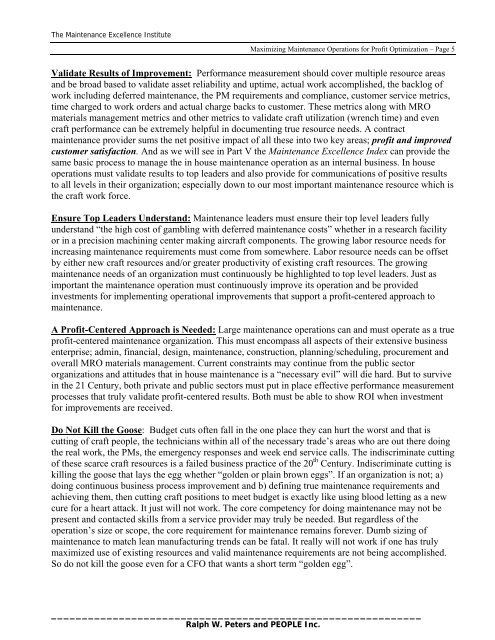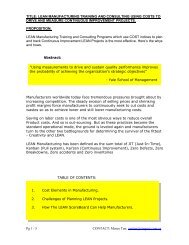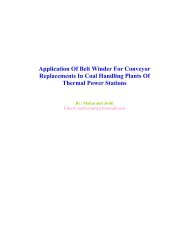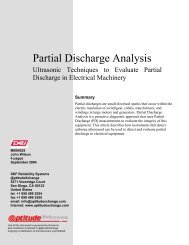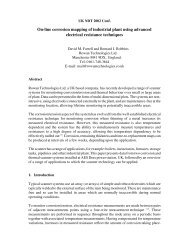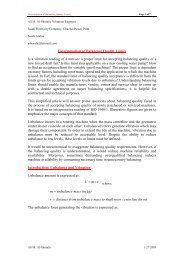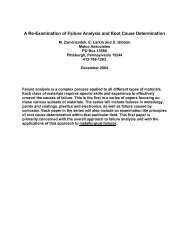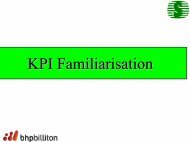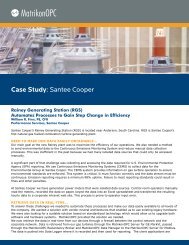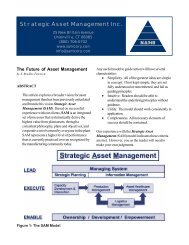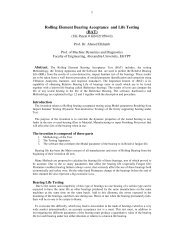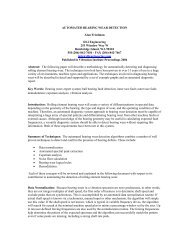Maximizing Maintenance Operations for Profit Optimization - Plant ...
Maximizing Maintenance Operations for Profit Optimization - Plant ...
Maximizing Maintenance Operations for Profit Optimization - Plant ...
You also want an ePaper? Increase the reach of your titles
YUMPU automatically turns print PDFs into web optimized ePapers that Google loves.
The <strong>Maintenance</strong> Excellence Institute<strong>Maximizing</strong> <strong>Maintenance</strong> <strong>Operations</strong> <strong>for</strong> <strong>Profit</strong> <strong>Optimization</strong> – Page 5Validate Results of Improvement: Per<strong>for</strong>mance measurement should cover multiple resource areasand be broad based to validate asset reliability and uptime, actual work accomplished, the backlog ofwork including deferred maintenance, the PM requirements and compliance, customer service metrics,time charged to work orders and actual charge backs to customer. These metrics along with MROmaterials management metrics and other metrics to validate craft utilization (wrench time) and evencraft per<strong>for</strong>mance can be extremely helpful in documenting true resource needs. A contractmaintenance provider sums the net positive impact of all these into two key areas; profit and improvedcustomer satisfaction. And as we will see in Part V the <strong>Maintenance</strong> Excellence Index can provide thesame basic process to manage the in house maintenance operation as an internal business. In houseoperations must validate results to top leaders and also provide <strong>for</strong> communications of positive resultsto all levels in their organization; especially down to our most important maintenance resource which isthe craft work <strong>for</strong>ce.Ensure Top Leaders Understand: <strong>Maintenance</strong> leaders must ensure their top level leaders fullyunderstand “the high cost of gambling with deferred maintenance costs” whether in a research facilityor in a precision machining center making aircraft components. The growing labor resource needs <strong>for</strong>increasing maintenance requirements must come from somewhere. Labor resource needs can be offsetby either new craft resources and/or greater productivity of existing craft resources. The growingmaintenance needs of an organization must continuously be highlighted to top level leaders. Just asimportant the maintenance operation must continuously improve its operation and be providedinvestments <strong>for</strong> implementing operational improvements that support a profit-centered approach tomaintenance.A <strong>Profit</strong>-Centered Approach is Needed: Large maintenance operations can and must operate as a trueprofit-centered maintenance organization. This must encompass all aspects of their extensive businessenterprise; admin, financial, design, maintenance, construction, planning/scheduling, procurement andoverall MRO materials management. Current constraints may continue from the public sectororganizations and attitudes that in house maintenance is a “necessary evil” will die hard. But to survivein the 21 Century, both private and public sectors must put in place effective per<strong>for</strong>mance measurementprocesses that truly validate profit-centered results. Both must be able to show ROI when investment<strong>for</strong> improvements are received.Do Not Kill the Goose: Budget cuts often fall in the one place they can hurt the worst and that iscutting of craft people, the technicians within all of the necessary trade’s areas who are out there doingthe real work, the PMs, the emergency responses and week end service calls. The indiscriminate cuttingof these scarce craft resources is a failed business practice of the 20 th Century. Indiscriminate cutting iskilling the goose that lays the egg whether “golden or plain brown eggs”. If an organization is not; a)doing continuous business process improvement and b) defining true maintenance requirements andachieving them, then cutting craft positions to meet budget is exactly like using blood letting as a newcure <strong>for</strong> a heart attack. It just will not work. The core competency <strong>for</strong> doing maintenance may not bepresent and contacted skills from a service provider may truly be needed. But regardless of theoperation’s size or scope, the core requirement <strong>for</strong> maintenance remains <strong>for</strong>ever. Dumb sizing ofmaintenance to match lean manufacturing trends can be fatal. It really will not work if one has trulymaximized use of existing resources and valid maintenance requirements are not being accomplished.So do not kill the goose even <strong>for</strong> a CFO that wants a short term “golden egg”.____________________________________________________________Ralph W. Peters and PEOPLE Inc.


